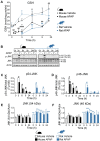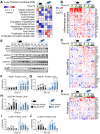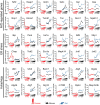A systems approach reveals species differences in hepatic stress response capacity
- PMID: 37647630
- PMCID: PMC10614045
- DOI: 10.1093/toxsci/kfad085
A systems approach reveals species differences in hepatic stress response capacity
Abstract
To minimize the occurrence of unexpected toxicities in early phase preclinical studies of new drugs, it is vital to understand fundamental similarities and differences between preclinical species and humans. Species differences in sensitivity to acetaminophen (APAP) liver injury have been related to differences in the fraction of the drug that is bioactivated to the reactive metabolite N-acetyl-p-benzoquinoneimine (NAPQI). We have used physiologically based pharmacokinetic modeling to identify oral doses of APAP (300 and 1000 mg/kg in mice and rats, respectively) yielding similar hepatic burdens of NAPQI to enable the comparison of temporal liver tissue responses under conditions of equivalent chemical insult. Despite pharmacokinetic and biochemical verification of the equivalent NAPQI insult, serum biomarker and tissue histopathology analyses revealed that mice still exhibited a greater degree of liver injury than rats. Transcriptomic and proteomic analyses highlighted the stronger activation of stress response pathways (including the Nrf2 oxidative stress response and autophagy) in the livers of rats, indicative of a more robust transcriptional adaptation to the equivalent insult. Components of these pathways were also found to be expressed at a higher basal level in the livers of rats compared with both mice and humans. Our findings exemplify a systems approach to understanding differential species sensitivity to hepatotoxicity. Multiomics analysis indicated that rats possess a greater basal and adaptive capacity for hepatic stress responses than mice and humans, with important implications for species selection and human translation in the safety testing of new drug candidates associated with reactive metabolite formation.
Keywords: acetaminophen; liver injury; oxidative stress; preclinical species.
© The Author(s) 2023. Published by Oxford University Press on behalf of the Society of Toxicology.
Figures








References
-
- Aithal G. P. (2010). Mind the gap. Altern. Lab. Anim. 38(Suppl. 1), 1–4. - PubMed
-
- Bernal W., Auzinger G., Dhawan A., Wendon J. (2010). Acute liver failure. Lancet 376, 190–201. - PubMed
-
- Boobis A. R., Tee L. B., Hampden C. E., Davies D. S. (1986). Freshly isolated hepatocytes as a model for studying the toxicity of paracetamol. Food Chem. Toxicol. 24, 731–736. - PubMed
MeSH terms
Substances
Grants and funding
LinkOut - more resources
Full Text Sources
Medical
Molecular Biology Databases

